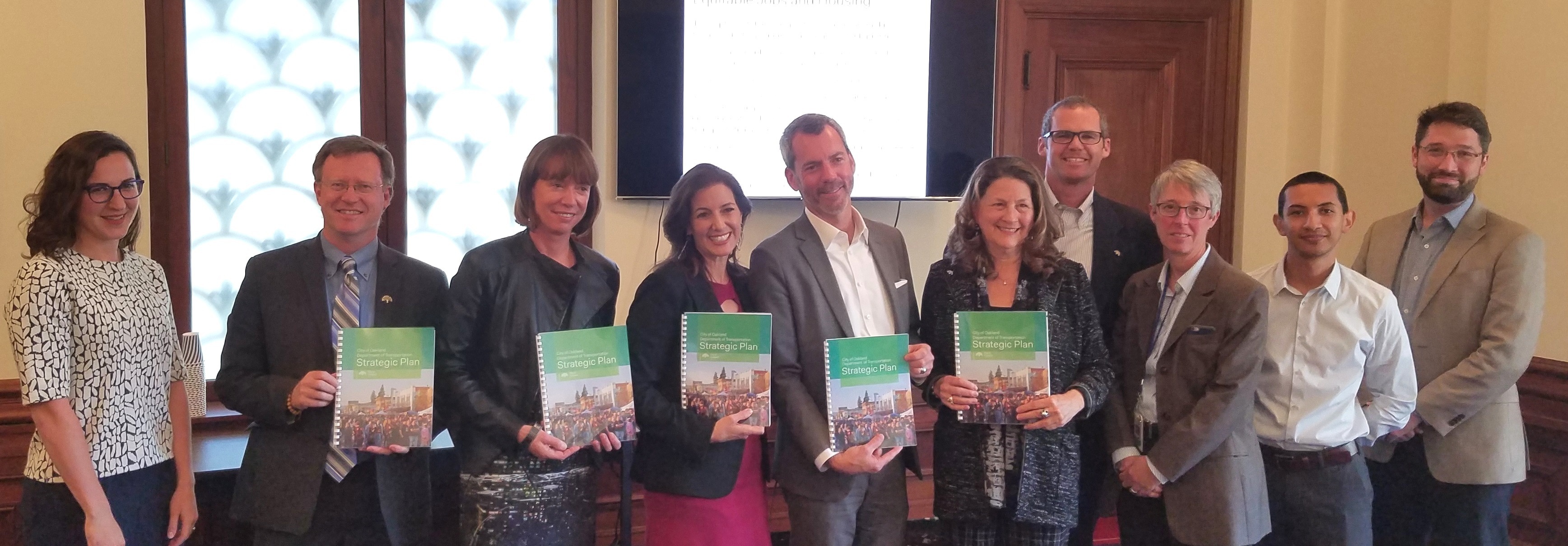News from: Office of the Mayor Libby Schaaf
Media Contact: Erica Terry Derryck, (510) 238-7072, ederryck@oaklandca.gov
FOR IMMEDIATE RELEASE
October 4, 2016
MAYOR SCHAAF AND CITY LEADERS DISCUSS EQUITY AND SAFETY GOALS IN NEW OAKLAND DEPARTMENT OF TRANSPORTATION’S FIRST STRATEGIC PLAN
AGENDA FOR MORE EQUITABLE TRANSPORTATION NETWORK, VISION ZERO, INCREASED PEDESTRIAN SPACE AND BIKING INFRASTRUCTURE
Oakland, CA — Oakland Mayor Libby Schaaf today released a strategic plan for the newly created Department of Transportation (OakDOT) with City Administrator Sabrina Landreth, interim OakDOT Director Jeff Tumlin, Public Works Director Brooke Levin, the Mayor’s Policy Director for Transportation and Infrastructure Matt Nichols, and Janette Sadik-Khan, a transportation advisor with Bloomberg Associates.
The 56-page document, which follows the creation of OakDOT in June, sets out a long-term vision for Oakland’s streets based on Mayor Schaaf’s core priorities, and includes detailed 1- and 3-year goals to repair and update city streets, provide more equitable access to jobs and services, and expand transportation options. The Plan also recommends that Oakland join the growing numbers of cities adopting Vision Zero policies with the goal of eliminating traffic deaths, including San Francisco and San Jose.
OakDOT comprises 270 staff and 18 work units formerly in Oakland’s Public Works and Police departments. Creating the agency was a key goal of Mayor Schaaf to help channel Oakland’s rapid change and growth for the benefit of all its residents. The release of the Department’s Strategic Plan is the latest in a series of significant actions to improve city planning and transportation policies and comes during the run-up to the local ballot measure Measure KK, which, if passed by voters, would dramatically expand OakDOT’s ability to bring city streets into a state of good repair. The plan can be viewed and downloaded here(http://bit.ly/oakdotplan16).
Key goals include:
· Accelerate repaving schedules to bring Oakland’s streets into a state of good repair
· Use equity to prioritize spending, so that resources are spent in the communities that need them most
· Adopt a Vision Zero policy and work harder to eliminate traffic fatalities and injuries
· Expand communication and listening between OakDOT and the public
· Adopt the Pedestrian Safety Plan and update the Bicycle Master Plan
· Create a citywide Vibrant Public Space program to expand opportunities community-requested plazas and other facilities
· Lower transportation costs, and improve access to schools and jobs
“We established this new Department so that transportation can help transform Oakland into a safer, more accessible and more equitable city,” said Oakland Mayor Libby Schaaf. “City staff have done a great job – this is their game plan to create a more a vibrant city, where drivers don’t get flat tires from potholes, but also where bus stops and crosswalks are safe for seniors and children, and where access to opportunity isn’t based on where you live.”
This plan provides a bold vision for Oakland, but more importantly it provides a practical roadmap to get there.
Sabrina Landreth, Oakland’s City Administrator added, “It’s very important to me that this Plan was actually written by the women and men who work in the new Department of Transportation. They are the ones who work really hard to keep Oakland moving, and they know what it will take, in very realistic terms, to make our city safer and more accessible to all our residents. I admire this plan’s commitment to strengthening community involvement and to using data to drive decisions and sharing that data with the public – this is an important way we are building a more accessible, transparent and accountable city government.”
“This Strategic Plan helps us see our streets not just as ways to get from here to there, but also to notice where those roads are leading,” said Interim Director of the Oakland Department of Transportation Jeff Tumlin. “Our streets provide access to jobs and education, schools and services. We need to see them as avenues for social and economic advancement. This is the first city government Strategic Transportation Plan in the nation constructed on the principle of equity, and that looks at every activity through a lens of how our streets can serve our goal of making the city more accessible, inclusive and fair.”
The Department’s Strategic Plan is built around Mayor Schaaf’s top four goals for her administration, which are: 1) Equitable Jobs and Housing; 2) Holistic Community Safety; 3) Vibrant Sustainable Infrastructure; and 4) Responsive Trustworthy Government. Through an extensive staff collaboration that involved all levels of the new department, from engineers to the crews who maintain the street signs and fill the potholes, the plan translates these goals into a comprehensive transportation agenda.
The plan arrives within weeks of the City Council’s approval of revisions to the city’s 50-year-old parking requirements, which can help accelerate more affordable-housing construction in Oakland; a recent change in planning guidelines, which will allow transportation planners to consider pedestrians, bicyclists and transit users on a more equal basis with people who drive; and with an upcoming ballot initiative, Measure KK, that could bring $350 million in funding to the newly organized OakDOT to undertake unprecedented road repair and redesign projects in every neighborhood, accelerating repair of the city’s crumbling infrastructure.
OakDOT and Oakland Public Works have already implemented a number of street-transforming projects, including the recently completed Latham Square rebuild; the redesign of Telegraph Avenue to improve pedestrian safety, a provide a protected bike lane. OakDOT is Many more projects are already in the works in the near term as the new agency develops, selects a permanent director, and works toward longer-term initiatives.
###
